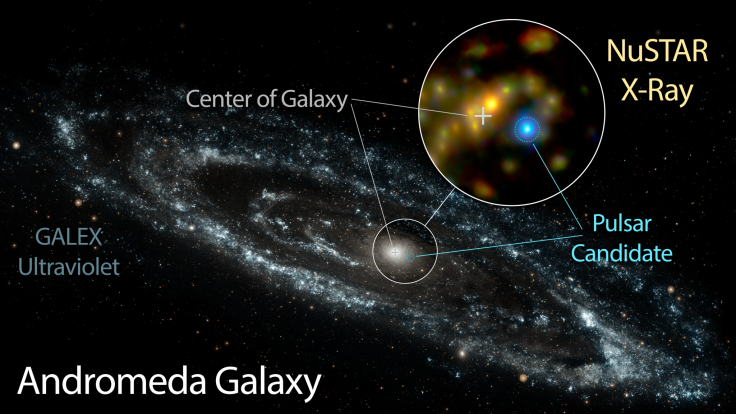NASA's NuSTAR Mission Reveals New Pulsar In Andromeda Galaxy

In 2013, observations made using NASA’s Swift satellite revealed the presence of a bright X-ray source in Andromeda (also known as M31) — a spiral galaxy located about 2.5 million light-years from Earth. Now, using data collected as part of the space agency’s Nuclear Spectroscopic Telescope Array (NuSTAR) mission, a team of astronomers has identified the object responsible for these high-energy bursts.
According to a study published Wednesday in the Astrophysical Journal, this object, called Swift J0042.6+4112, is most likely a pulsar. Observations made using NuSTAR suggest that the object’s emission spectrum is very similar to known pulsars in the Milky Way.
“Traditionally, astronomers have thought that actively feeding black holes, which are more massive than pulsars, usually dominate the high-energy X-ray light in galaxies. As gas spirals closer and closer to the black hole in a structure called an accretion disk, this material gets heated to extremely high temperatures and gives off high-energy radiation,” NASA said in a statement released Thursday. “This pulsar, which has a lower mass than any of Andromeda's black holes, is brighter at high energies than the galaxy's entire black hole population.”
Pulsars are rapidly rotating neutron stars, and were first discovered nearly 50 years ago. As a pulsar rotates, it emits high-energy radiation into the cosmic void, similar to a lighthouse, casting beams of light. If this beam of high-energy radiation is pointed toward the Earth, the pulsars can be detected using telescopes.
In this particular case, the pulsar is most likely part of a binary system, and is probably pulling material from the companion star and heating it up. The pulsar, which has a lower mass than any of Andromeda's black holes, is much brighter at high energies than the galaxy's entire black hole population.
Given that Andromeda is the closest spiral galaxy to the Milky Way, and can therefore be easily observed, astronomers have had a longstanding interest in studying it to look for clues to the formation and evolution of our galaxy.
“Since we can't get outside our galaxy and study it in an unbiased way, Andromeda is the closest thing we have to looking in a mirror,” study co-author Ann Hornschemeier from NASA’s Goddard Space Flight Center, Greenbelt, Maryland, said in the statement.
© Copyright IBTimes 2025. All rights reserved.






















